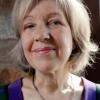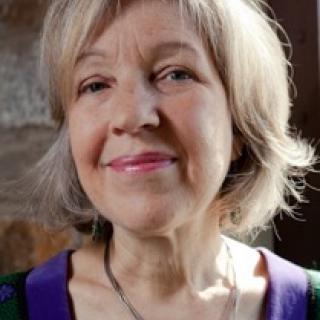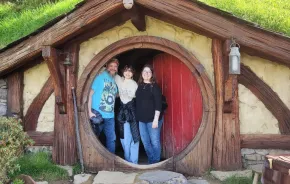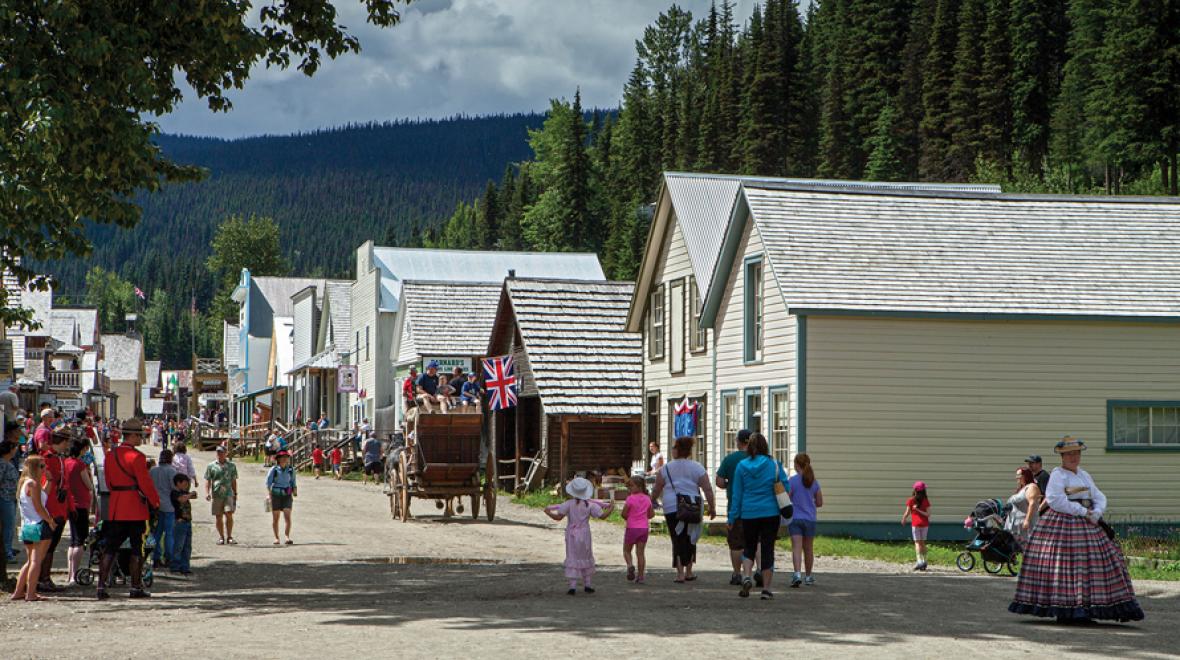
Photo:
Photo credit: Thomas Drasdauskis
Think that all the famous 19th-century gold rushes were only in California and Alaska? Don’t forget British Columbia. The Cariboo gold rush began in 1858, drawing thousands of people into western Canada and to gold deposits along the Fraser River Valley. Would-be millionaires began prospecting near the town of Yale, some 83 miles east of the present-day city of Vancouver, and made their way 350 miles north to an area that eventually became known as Barkerville.
Read more Family Adventure Guide stories! Find your summer bucket list, dock-to-table vacations, best summer splurges and more
Situated 4,300 feet above sea level on the western edge of the Cariboo Mountains, Barkerville was named after British prospector Bill Barker, whose gold strike near Williams Creek in 1862 revealed the world’s largest creekside gold nugget deposit. Once word of Barker’s find got out, the world rushed in. The resulting fame made Barkerville the largest city west of St. Louis and north of San Francisco, at least for a few years. Guides in Barkerville will tell you about the 10,000 men prospecting in the area in the 1860s who kept two dozen blacksmiths very busy.
More than 150 years later, families can experience the gold rush era for themselves in today’s Barkerville, which has become the largest living-history museum in western North America. It comprises 169 historic buildings or their replicas on 1,130 acres (almost four times the size of Colonial Williamsburg), several dozen costumed employees at 18 period businesses, four historic cemeteries, three bed-and-breakfasts and three campgrounds. But few Americans have heard of the place, even though it was declared a National Historic Site of Canada in 1924.
I first heard of the historic town when we drove by there on our way to Alaska two years ago. I circled back last summer when my daughter was 11. Our two-night stay was a rich lesson in how the Canadian West was won. For Seattle families that are interested in gold mining, adventure and a full immersion into 19th-century frontier life, a Barkerville trip is well worth the drive.
From gold panning to ‘bride boats’: A day in Barkerville
A typical day in Barkerville starts at the visitor center, where a daily schedule of dozens of events is posted, beginning with morning prayer at the local Anglican church. Visitors will immediately notice a dirt road heading uphill through Barkerville, which quickly turns to mud if it’s raining. From there, you can explore the local print shop, the smithy or the local cemeteries; observe several musical revues; or ride a stagecoach up the hill to the local courthouse 1 mile away. There, actors dressed as 19th-century magistrates reminisce about the cases of the day. Altogether, there are more than 125 sites to visit.
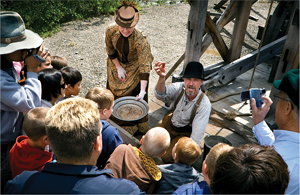
There are many opportunities to learn about and participate in gold rush history. Find a mining museum and a demonstration of how gold was mined at the Barker & Co. Shaft House. At the Eldorado Gold Panning and Gift Shop, owned by three brothers, the whole family can pan for gold flakes and chips in a simulated creek. Don’t miss the waterwheel demonstration, a 40-minute, interactive show featuring two unscrupulous miner owners who try to get the audience to buy bogus shares in their mine.
Throughout the town, costumed employees, including 18–24 professional actors, work, dress and talk much like settlers from the 1860s. On our visit, one such actor played the part of “Miss Florence Wilson,” who had come to Canada on a “bride boat” from Britain in 1864 for the benefit of lonely male miners. This entertaining performer wore a blue and white dress (complete with a hoop skirt), a straw hat, a black belt with a large silver buckle and a silver locket. She also carried a parasol, which she would wave about as she gave us a tour of the town.
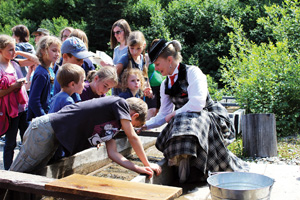
We also enjoyed “Mrs. Thompson,” a grouchy schoolteacher — dressed in a long skirt with a bustle and a bonnet — who ushered us into the 1874 schoolhouse to learn the three Rs the Victorian way. We crammed ourselves behind small wooden desks facing a wood-burning stove. She reprimanded anyone who didn’t address her as “ma’am” or stand when they answered a question. People were instructed to sit separately by sex, all females had to wear bonnets and we had to examine each other’s hair for lice. Another actor played Barker himself, reminiscing on the steps of a mid-town cabin about the sudden fame he brought to the Cariboo wilderness.
Exploring Barkerville’s Chinatown
A highlight of a Barkerville visit is Chinatown, located on the upper end of town and decorated with red banners, red Chinese lanterns and flags. Consider taking a history tour led by Ying-ying Chen or one of her Mandarin- or Cantonese-speaking assistants. As Chen, who teaches at Simon Fraser University, takes visitors through the streets of Chinatown, she brings to life the fascinating story of how 5,000–8,000 immigrants from China’s Pearl River Delta made the voyage across the Pacific, then traveled on foot from New Westminster to Barkerville (a three-week walk) to labor in the gold fields.
The town’s 18,500 historic Chinese items are part of the largest Chinese history and documents collection in North America, all of which is on site in Barkerville. The site also has the largest collection of pre-1880s Chinese buildings on the continent. (Note: Kids may get restless during Chen’s tour, but my daughter was mollified by a subsequent visit to a Chinese merchant who sold us a pink parasol.) Kids will also enjoy exploring Chinese shops and trying calligraphy. Hungry? Grab a bite at the Lung Duck Tong Restaurant.
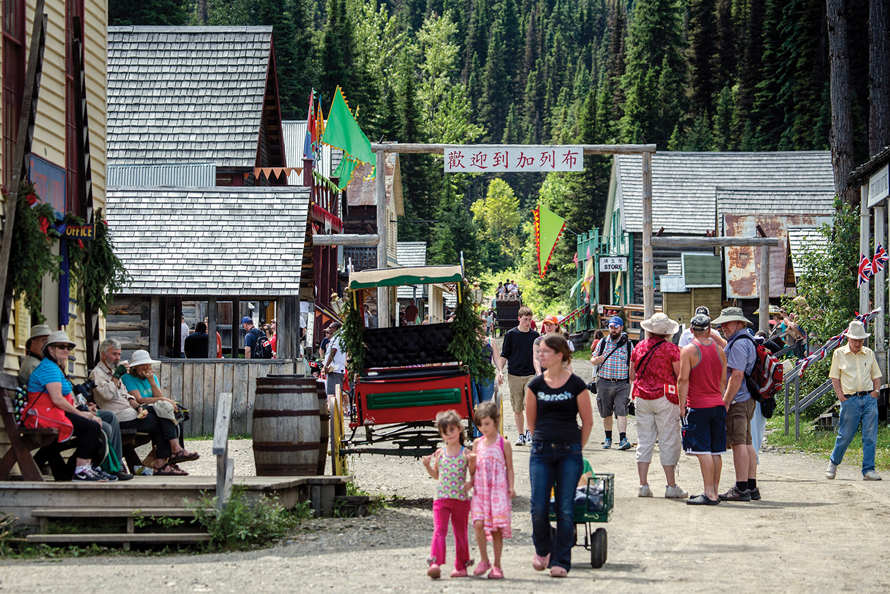
The gold rush at Barkerville and elsewhere on the Cariboo Wagon Road was part of a 20-year, multibillion-dollar industry that established British Columbia as a resource-rich province. Before the gold rush, the territory was controlled by the Hudson’s Bay Company. As Americans from the California gold rush poured into the area, the English settlers realized they had better make the region a British crown colony if they wished to retain control of this region north of the 49th parallel.
During our trip to Barkerville, the human-interest stories I picked up about the people who were drawn to this wilderness were so compelling that I bought a history of the Canadian gold rush at a bookstore in the town of Quesnel, 55 miles away. A visit to Barkerville allows you to step back two centuries to a relatively undiscovered era of North American history and understand the passions of those who lived and died for gold.
Barkerville basicsCost: Two-day admission to Barkerville, in Canadian dollars, is $14.50 for adults, $9.50 for children ages 13–18, $4.75 for children ages 6–12, and free for those who are younger. Canada is celebrating its 150th birthday in 2017 and is granting free admission to its national parks if you order a Discovery Pass online. Barkerville is a national historic site (not a park) so the Discovery Pass doesn’t apply, but passholders do get a 20 percent discount on admission fees. Where to stay: Reserve a space at one of the three bed-and-breakfasts in town, as Barkerville is 55 miles away from Quesnel, the closest city of any size. We stayed at the Kelly House (rooms start at $98/night), where the huge farm breakfasts were works of art and there was an interesting mix of guests each night. St. George Hotel, a former saloon and brothel, is more expensive and does not allow children younger than 12. There are also three nearby campgrounds — the smallest, Government Hill, is within walking distance of the town — and a handful of lodgings in nearby Wells. What to eat: Barkerville has a confectionary, a bakery, a coffeehouse and two restaurants: Wake Up Jake and Lung Duck Tong. Three miles away, in Wells, you’ll find a bakery and a handful of other restaurants. Good to know: Barkerville’s main season in 2017 runs from May 18 to Sept. 24, although it does open at other times of the year for some holiday and winter activities. There is internet at the visitor center and the bed-and-breakfasts, but no cellphone service anywhere in town. Also, a warning: Do not arrive past 6 p.m., after which the town really shuts down and it can be tough to access your lodging and other amenities (we learned this the hard way). Getting there: From Seattle, it is a scenic 532-mile drive to Barkerville, with mountains, tourist facilities and lots of historic gold rush sites along the way. Nearby fun: The road to Barkerville also leads to Bowron Lake Provincial Park, known for its chain of 10 lakes, where canoeists can paddle a 72-mile circuit with some portaging. On Highway 26 west of Barkerville, the Cottonwood House Heritage Site is an old roadhouse built for gold prospectors in 1864. About 5 miles west of Quesnel, Pinnacles Provincial Park has a wonderful hike — lasting about an hour — overlooking limestone hoodoo formations on Baker Creek. Info: Check out the town blog for activities and news. |
Fun facts about the Cariboo gold rush
The precursor to the 1862 Cariboo gold rush was the Fraser River gold rush of 1858, closer to the present-day city of Vancouver. About 500 British colonists lived in what would become the province of British Columbia at the beginning of 1858. Within a year, the population had surged to 30,000.
Women were in such short supply in western Canada that mission societies were formed in England for the purpose of sending marriage-minded single women to the frontier. They sailed on “bride ships” bound for Victoria, B.C., and from Victoria, traveled on to the goldfields.
The route to Barkerville from Yale was marked by roadhouses named for the distance traveled from Yale on the Cariboo Wagon Road. Today, there are still towns called “150 Mile House,” “100 Mile House” and “70 Mile House.” At 150 Mile House, be sure to stop at a restored 1896 schoolhouse, which features double desks, a cloak room, a barrel stove and separate outhouses for boys and girls.



